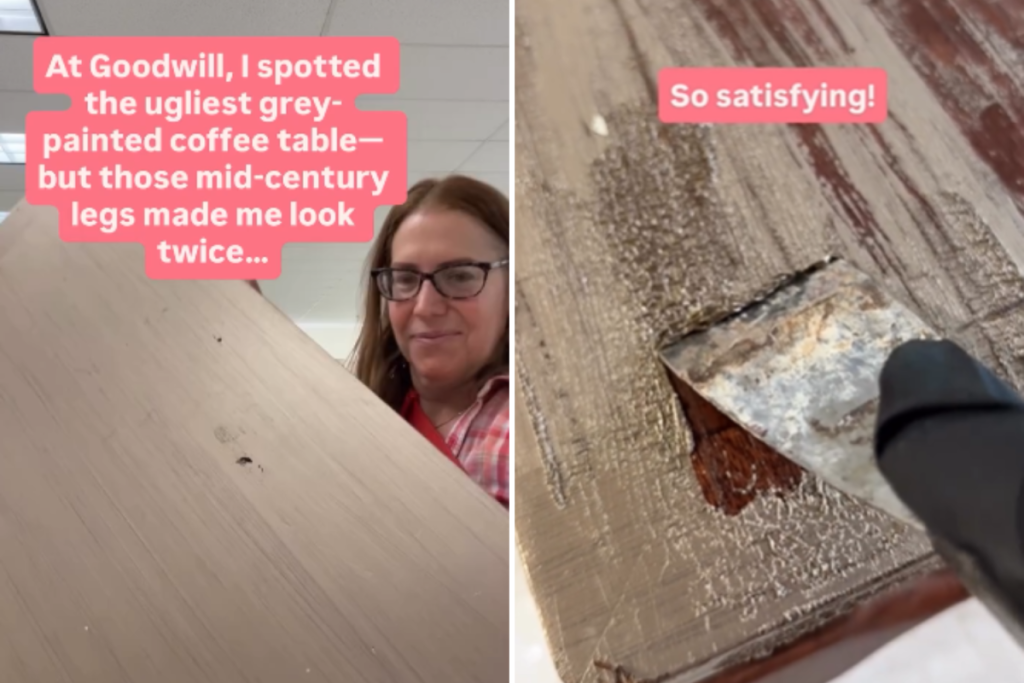From Discarded to Discovered: The Revival of a Midcentury Classic
In a world where mass-produced furniture dominates our homes and landfills, Jennifer Armstrong’s story offers a refreshing reminder of the treasures hiding in plain sight. The 56-year-old thrift hunter was making one of her routine “quick sweeps” through the Goodwill store in Swarthmore, Pennsylvania, when an unremarkable gray-painted coffee table caught her expert eye. While most shoppers walked past the seemingly ordinary piece, Armstrong’s trained gaze immediately recognized the distinctive midcentury-modern legs beneath the dull paint job. “I immediately recognized the shape of the legs and was hoping they were original midcentury-modern—not just a modern reproduction,” she shared with Newsweek. That moment of recognition would lead to a remarkable find that highlights both the value of vintage expertise and the concerning disposability of modern furniture culture.
Upon flipping the table over, Armstrong’s excitement was confirmed by the unmistakable Lane brand mark, complete with style and serial number. Lane, a celebrated American furniture company, is known for crafting durable, stylish midcentury pieces that have stood the test of time since the mid-20th century. “My heart skipped a beat when I saw the Lane brand name,” Armstrong recalled of the moment she realized what she’d found. The serial number revealed the table’s birthday: August 25, 1956, making it a genuine midcentury artifact. Not wanting to lose her discovery, Armstrong quickly secured her purchase receipt and hurried to the checkout counter. The price tag was almost as surprising as the find itself—just $7.99, further reduced to $5.59 thanks to the store’s Wednesday senior discount. This same table, in proper condition, typically sells for between $650 and $3,900 online, with many commanding around $1,300.
The table’s journey from forgotten castoff to cherished find represents more than just a lucky bargain. Its flat gray paint concealed the beautiful wood grain beneath, while its chewed corner—which Armstrong jokingly attributed to a puppy—told stories of its previous life. Rather than seeing these imperfections as deterrents, Armstrong viewed them as an opportunity to bring the piece back to its original glory. She immediately began the restoration process, using a carbide scraper to remove the layers of paint and original stain. “Next, I’ll be finely sanding and re-staining. I’ll also repair the corner before listing it for sale,” she explained, documenting the transformation on social media where fellow vintage enthusiasts could follow along. Though she admits she’d love to keep the piece for herself, her mini schnauzer’s attachment to a different vintage ottoman means this Lane table will soon find a new home through her Etsy or eBay shop.
Armstrong’s rescue of this Lane table stands in stark contrast to today’s furniture consumption patterns. While midcentury pieces were built with quality materials and construction techniques designed to last generations, much of today’s furniture follows what Armstrong calls the “fast fashion” model—cheaply made, quickly disposed of, and easily replaced. This shift has had devastating environmental consequences. According to EPA data, Americans generated just 2.2 million tons of furniture waste in 1960. By 2018, that figure had exploded to over 12 million tons annually, with more than 80 percent sent directly to landfills. Only a small fraction is recycled or repurposed. “The amount of furniture piling up in landfills is growing exponentially,” Armstrong notes with concern, highlighting how solid wood classics built to endure decades increasingly end up discarded or, in rare fortunate cases like her Lane table, donated.
Armstrong’s discovery is part of a growing trend of thrift store treasures being recognized and rescued by knowledgeable hunters. Her story joins others, like the woman who found a couch worth thousands for just $129, or another thrifter who discovered a marble table worth thousands for a mere $100. These stories speak to the hidden value sitting on thrift store shelves across America, waiting for the right person with the right knowledge to recognize their worth. They also reveal a generational disconnect—as knowledge of quality furniture construction fades, more valuable pieces are discarded by those who don’t recognize their significance. Armstrong’s trained eye represents a crucial link in preserving these pieces of American craftsmanship that might otherwise be painted over, damaged, or worst of all, relegated to landfills.
The revival of Armstrong’s Lane coffee table represents more than just a profitable flip or a social media restoration story—it’s a small but meaningful act of conservation. By rescuing, restoring, and rehoming this piece of American craftsmanship, Armstrong ensures it will continue its journey through another generation of homes. Her work speaks to a growing counter-movement against disposable culture, where quality, repairability, and longevity are once again being valued over convenience and low initial cost. As more consumers recognize the environmental and cultural impact of “fast furniture,” stories like Armstrong’s serve as inspiration for a different approach—one where we might look at that old wooden table or chair with fresh eyes, seeing not just what it is, but what it could be with some care and attention. In saving one coffee table from an ignominious fate under a coat of gray paint, Armstrong reminds us of the value of looking beneath the surface, both literally and figuratively, to discover the beauty and quality that might be hiding there all along.















